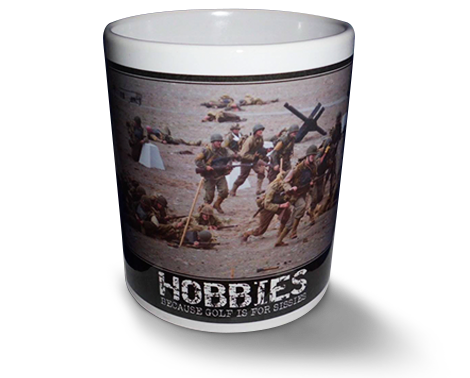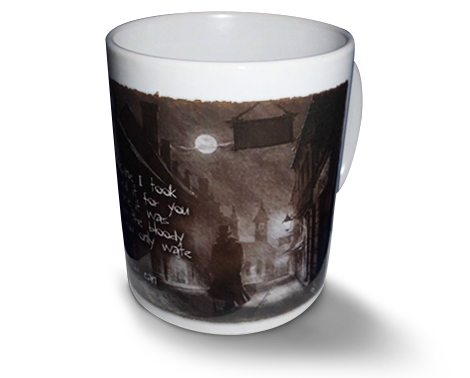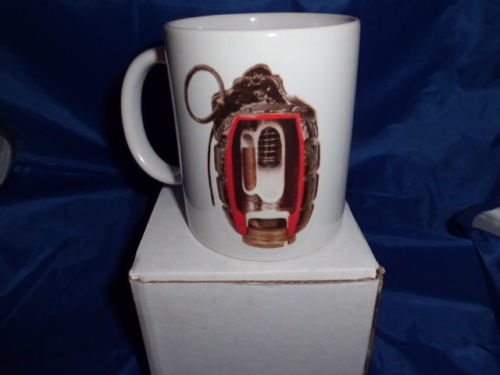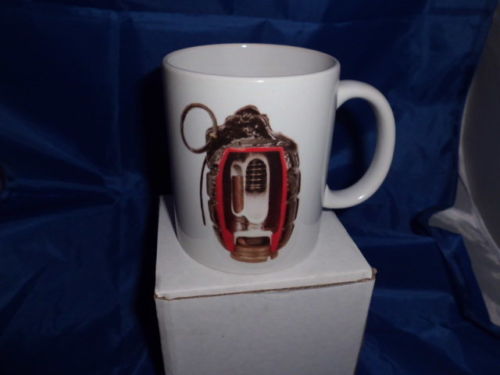Mills Grenade military mug
Mills Grenade mug
11oz.
It's finally here, the most extreme Mills grenade printed mug
that's guaranteed to Make You feel Dangerous. You've seen The Mug factory deliver an outstanding printed mug with dishwasher safe technology updated and better than ever. Now even looks explosive !!!
Now you stay energised with your favorite brew in your favorite pritned mug!
The mugs we use are top quality bright white, Orca coated, and are Dishwasher and Microwave safe, the high quality images are bonded into the surface of the mug, and do not fade or peel off like transfers
GREAT FOR GIFTS, BIRTHDAYS, OR JUST TO ADD TO YOUR MEMORABILIA COLLECTION.
The artwork is created in our offices/workshop, and we are available for custom work. These designs are individually made, not mass produced.
Please note that I take great care in packaging the mugs they are sent in a polystyrene mug box designed to specifically for posting mugs hence the postage costs
William Mills a hand grenade designer from Sunderland, patented, developed and manufactured the "Mills bomb" at the Mills Munition Factory in Birmingham, England, in 1915. The Mills bomb was inspired by an earlier design by Belgian captain Leon Roland. Roland and Mills were later engaged in a patent lawsuit. The Mills bomb was adopted by the British Army as its standard hand grenade in 1915, and designated the No. 5.
The Mills bomb underwent numerous modifications. The No. 23 was a variant of the No. 5 with a rodded base plug which allowed it to be fired from a rifle. This concept evolved further with the No. 36, a variant with a detachable base plate to allow use with a rifle discharge cup. The final variation of the Mills bomb, the No. 36M, was specially designed and waterproofed with shellac for use initially in the hot climate of Mesopotamia in 1917, but remained in production for many years. By 1918 the No. 5 and No. 23 were declared obsolete and the No. 36 (but not the 36M) followed in 1932.
The Mills was a classic design grooved cast iron "pineapple" with a central striker held by a close hand lever and secured with a pin. According to Mills's notes, the casing was grooved to make it easier to grip and not as an aid to fragmentation, and in practice it has been demonstrated that it does not shatter along the segmented lines. The Mills was a defensive grenade: after throwing the user had to take cover immediately. A competent thrower could manage 15 metres (49 feet) with reasonable accuracy, but the grenade could throw lethal fragments farther than this. The British Home Guard were instructed that the throwing range of the No. 36 was about 30 yards with a danger area of about 100 yds.
At first the grenade was fitted with a seven-second fuse, but during combat in the Battle of France in 1940 this delay proved to be too long, giving defenders time to escape the explosion, or even to throw the grenade back, and was reduced to four seconds.
The heavy segmented bodies of "pineapple" type grenades result in an unpredictable pattern of fragmentation. After the Second World War Britain adopted grenades that contained segmented coiled wire in smooth metal casings. The No. 36M Mk.I remained the standard grenade of the British Armed Forces and was manufactured in the UK until 1972, when it was completely replaced by the L2 series. The 36M remained in service in some parts of the world such as India and Pakistan, where it was manufactured until the early 1980s. Mills bombs were still being used in combat as recently as 2004 e.g. the incident which killed US Marine Jason Dunham and wounded two of his comrades.
Models
The No. 5 Mk. 1 was the first version. The explosive filler was loaded through a small circular plug on the upper half, the detonator assembly was loaded through the bottom through the baseplug, and the pull-ring striker was screwed in to the fuze well at the top. The lever was protected by metal "ears" flanking the top that could be used to locate it in darkness. It was first issued in May, 1915 but wasn't in general issue until mass production caught up a year later in 1916. The Mk. 2 had a redesigned stronger safety lever.
The No. 23, the rifle-grenade model, first appeared in 1917. The No. 23 Mk. 1 had a redesigned, narrower baseplug that was centrally threaded underneath so it could attach the rifle rod. The Mk. 2 and Mk. 3 were product-improved versions designed to make it cheaper and easier to produce.
The improved No. 36 Mk. 1 was first introduced in May, 1918. It was wider in the middle, had larger lever "ears", and had an optional gas-check disk to allow it to be launched out of a blank-propelled cup-discharger. The shellac-coated "Mesopotamian" variant (No. 36M) was designed to keep moisture and humidity out of the detonator's fuse. The No. 36M Mk. 1 was the British army's standard hand-grenade from the 1930s to the 1970s.
Identification mark
A green band around the middle originally indicated an Amatol filling (1915–1920s), while it later indicated a Baratol or Trotyl filling (1920s–1970s).
A pink band around the middle indicates an Ammonal or Alumatol filling. (Alumatol is defined by the Dictionary of Explosives, pub 1920 as 'a mix of ammonium nitrate, TNT and 'a small quantity' of aluminium power.) A red band around the base plug on the bottom indicated the detonator was already installed and that the grenade was live.
Three red X's along each side indicates that it is the waterproofed No.36M model.
Rifle grenade
The Mills bomb was developed into a rifle grenade by attaching a metallic rod to its base. This rod-type rifle-grenade had an effective range of about 150 yards. The operating procedure was to insert the Mills bomb rod down the barrel of a standard rifle, put a special blank cartridge in the rifle chamber, place the rifle stock on the ground, then pull the Mills Bomb safety pin, releasing the safety spoon and immediately fire the rifle. If the soldier did not launch the grenade quickly, the grenade's fuse would time out and explode. The British soon developed a simple cradle attached to the rifle's bayonet fixing to hold the safety-spoon in place and prevent accidental detonations. However, it was found that the repeated launching of rod-type grenades caused damage to the rifle's barrel.
The British subsequently developed a cup-type launcher to replace the rod-type rifle-grenade. In this design, a can-shaped launcher was attached to the muzzle of the rifle and a gas check disc was screwed onto the base of the grenade before the grenade was placed in the launcher. The safety pin could then be removed as the launcher cup kept the safety-spoon in place. The operator inserted the blank cartridge into the rifle before setting the stock, angled on the ground to absorb the recoil of the weapon. When the cartridge was fired it pushed the grenade out of the cup releasing the spoon. The cup-type launcher could launch the grenade about 200 yards. Lee–Enfield rifles equipped with the cup launcher were modified with copper wire wrapped around the stock, to prevent the wood from cracking under the increased recoil. If necessary, both the rod and the gas check grenade could be thrown as a standard hand-grenade.
The turbines bomb hand grenade
when the empires of Europe clashed in 1914, army commanders struggled to conform to the new weapons to be had on an industrial scale. navy technology became similarly evolved, and new ways discovered to apply it. in this weblog post, we test the , first British hand grenade ever to be issued on a large scale.
improvement of the No.five Mark 1
for the duration of the primary world conflict, the struggle branch believed that the Belgian designed self-igniting hand grenade might be a precious asset for British soldiers inside the trenches. Patented in 1912 via Captain Leon Roland of the Belgian military, the Compagnie Belge de Munitions (CBdM) become mounted so one can market the grenade to a British manufacturer.
The assignment changed into given to of mills Co. An experienced engineer, he become given the assignment of redesigning the grenade, making it more secure and more efficient than its Belgian counterpart.
shiny black painted hand grenade
After some false starts, turbines in 1915 despatched prototypes to the troops in France of his solid iron bodied, egg formed grenade. subsequently this prototype have become the No.five Mark 1 and was the first British hand grenade ever to be issued on this sort of huge scale.
equivalent to a small pineapple due to its segmented outer form, these segments had been originally designed to fragment. because of the nature of explosives, however, they did not do so, however instead provided a company grip inside the moist conditions of the trenches.
How changed into it used?
To detonate the grenade the safety pin needed to be eliminated. once the pin became pulled out, with the aid of use of the attached ring, the person might keep the lever down and put together to throw. while thrown the lever might launch. as the lever released the striker would drop onto a percussion cap, the blast from which lit the fuse. This burned for five seconds before it reached the detonator.
a good bomber could have in an effort to throw a bomb to a distance of around 30.five m (100 toes), hence protecting themselves from the blast. It turned into deemed that cricketers, specially people with an amazing bowling arm, made the only bombers.
The No.5 grenades had been provided to the infantry in timber chests, each containing 12 grenades, with a tin of igniter units. these whole detonator devices each comprised the detonating price, a 5-second fuse, and a cap chamber housing the beginning percussion cap, together with a base plug key.
educational diagram showing the turbines Hand Grenade, Godstone Grenade school, Britain, 1917, taken from a free-leaf notebook belonging to Lieutenant J.M.Y Trotter, No.2 Officer Cadet Battalion, regarding his training.
Arming a generators bomb turned into sincere, requiring only that the base plug be unscrewed, the detonator assembly inserted and the plug screwed go into reverse. This became usually performed in advance of time and while in cover, however remained an inherently volatile task. non-public Clarrie Jarman, a scout bomber of the seventh Queen’s Regiment recalled: “there has been a bang and screams and the stretcher bearers went on the double to a few terrible devils who had permit their concentration wander.”
private reminiscences
personal J. Curdie, 6th Battalion, Highland light Infantry/Royal Flying Corps
.
personal Thomas Nash, Manchester Regiment
[">undefined being beneath device gun and artillery hearth, and going ‘over the top’ with bayonets fixed. He enlisted in 1916 and served on the Western the front.
What effect did they have on trench conflict?
those grenades had been an critical a part of trench conflict, in particular at some stage in raids. apparently, notes from a bombing route that occurred on the faculty of fingers in Hythe in January 1920, nonetheless taught the approaches of bombing a trench. It needs to be concluded that the training found out from the struggle impacted at the future of bombing and what methods to use to gain top of the line effect.
so as to storm a trench you would want eight men and one inside the following formation:
number 1) Rifleman equip with three bombs for emergency, his number one assignment turned into to “precede the birthday party down the ditch and by his bayonet repel enemy onslaught.”
No 2) Bayonet guy, who handed back messages from the rifleman to the thrower.
No three) the first thrower, he carries as much as 12 bombs, “his responsibility is to bomb the primary trench as a ways forward as viable.”
No 4) Acts as service to the thrower assisting throwing where feasible, his primary obligation is to bomb conversation trenches.
No five) The N.C.O. who is additionally equip with a few bombs.
No 6) the second one thrower whose undertaking is to additionally bomb conversation trenches, however he stops and bombs the communique trench till every other section from the rear take over. He also replaces the 1/3 guy if he will become a casualty.
No 7) Assists the 6th man as a service and auxiliary bomber.
No eight and 9) Are rifle bombers. they carry 12 bombs and an adequate deliver of rods (that are inserted into the grenade at one cease and into the barrel of the rifle at the other) so if vital they are able to use the throwers bombs and vice versa.
The 0.33 and fourth guys have to be together if possible and the 8th and 9th, however bunching the segment together is to be prevented because the whole birthday party may suffer from one bomb.
Like many of the weapons evolved for industrial scale use in the course of the primary international war, the mills bomb described a class of grenade that remained the usual British fragmentation grenade for over 55 years.
the Mills bomb
the no.five grenade became designed via sunderland-born engineer william generators and taken into service with the british navy in can also moreover 1915. greater typically referred to as the generators bomb, the no.5 have become a percussion cap fragmentation grenade that was crafted from solid iron and maximum normally full of the explosives, ammonal or amatol. it proved a robust and effective weapon on the battlefield and, with subsequent variants and marks, have grow to be the standard hand grenade for the the rest of the first world struggle.
first produced at the generators munition production unit in birmingham, the grenade modified into loosley-based totally on a layout via leon roland, an officer in the belgian army who modified into captured in november 1914, and his compatriot albert dewandre. mills advanced their early prototype with the aid of the use of adding his very very own specific factors and produced a design so a hit in concern trials that production of the grenade, particular the no.5 mark i, started in early 1915.
presenting a special cast iron segmented “pineapple” frame, the no.5 contained a essential firing striker that modified into held with the useful resource of an outside lever and secured with a protection-pin. it was generally full of ammonal, an explosive mixture along with tnt, ammonium nitrate and aluminium powder, and had a time-delay fuse of four.five seconds. to hearth the no.5, it changed into held with the striker degree firmly closer to its body while the protection pin become removed through its circular ring. the grenade have become then thrown, freeing the strain from the striker lever to initiate the time-put off fuse.
two versions of the no.5 have been produced at some point of the conflict that enabled it to be fired from a rifle. the no.23 allowed an eight inch firing rod to be screwed into its base plug, even as its successor, the no.36, featured a fuel-take a look at disc on its base that was designed to be used with a discharger cup attached to the muzzle of the short mag lee-enfield. a similarly version of the no.36 grow to be then produced which grow to be sealed with shellac to prevent corrosion of the grenade and its detonator fuse. to begin with designed for use in mesopotamia, the no.36m become added in 1917 and can stay in provider with the british army for the subsequent six many years. the variations had been typically full of amatol before being the explosive have become changed at a later date via way of baratol.
Mills Grenade Manufactures A - z
Most Mills grenades are stamped up in various locations with manufactures marks. All parts can be marked, the body, lever, centre column, filler caps and of course the base nut. The base nuts have always been popular with relic hunters and collectors, offer an insight into how large the scale of production must have been to need so many companies to produce vast amounts of this single type of grenade spanning two World Wars.
A - 36 Bodies - Anderson Engineering Christchurch, New Zealand
A B & S Ltd - 5Mk1+2, 36Mk1 - A Barrett & Sons 63 & 64 Picacilly, London
ACM - 36 Bodies - Ames Crosta Mills Moss Iron Works, Heywood, Lancs
AM&Co.' and 'AM' (followed by a number) - 36Mk1 - A. Marston & Co Marstons Lock Factory, Wolverhampton
A.L.& Co - 23Mk1 - Asa Lees & Co Ltd. Soho Iron Works, Oldham.
ALLEN WEST or AW&Co or AWCo - 5Mk1 - Allen West & Co. Lewis Road, Brighton
APX - Royal Ordnance Factories
AW - 36Mk1 - Acme Wringers David Street, Glasgow
BBC - 36Mk1 - British Bath Co. Greenford
B & D - 5 and 23 - Brooks & Doxey Junction Iron Works, Miles Platting, Manchester
Barber & Sons Ltd - 5Mk1 - Barber & Sons Ltd West Bromwich
BEC LD - 5Mk1 -Birmingham Engineering Co. Ld The Kings Road, South Yardly, Birmingham.
BGL - 5Mk1 - Birmingham Guild Ltd. Birmingham
B&G LD - 36Mk1 - Brown & Green Ltd Iron founders & Engineers, Windsor Street, Luton
B LD - 5 - Bullers Ltd Tipton, Staffordshire
BM - 36 Bodies - Booth McDonald BM. Booth McDonald Christchurch New Zealand
BRYANT - 5Mk1 - Bryant & Sons Birmingham
Burman & Sons' (solid thick brass version where made) & 'BURMAN' - 5, 23Mk1 - Burman & Sons Ryland Road, Birmingham.
Bullers Ltd - 5Mk1 - Bullers Ltd 6, Laurance Pountney Hill, London.
BW LTD - 5 and 23 - Bowden Wire LondonBS or HBS - Grenades Royal Ordnance Bishopton Strathclyde, Scotland
B.S. - British United Shoe Manufacturing Co. Ltd.
C (on body) Chatco (on safety lever) - 36Mk1 - Chatham Co. Chatham Ont. Canada
C in pentagon 5Mk1 Castings Ltd, Selbourne Street, Walsal
CAV - 5 and 23Mk1 - C.A.Vandervell & Co Warple Way, Acton Vale, London W3
C/A - 36 Bodies - Callenders Abbots Foundry Co Ltd Glasgow, Scotland
C & H LD - 5Mk1 - Chamberlain & Hookham Ltd Solar works, 4 New Bartholomew Street B,ham.
CC - 36Mk1 - Carron Company Falkirk, Scotland
CEW - 36Mk1 - Central Engineering Works South African
CMCo or CALTHORPE MOTOR CO LTD - 5Mk1 - Calthorpe Motor Co. Ltd. Bordesley Green, Birmingham,
CY - Grenades Royal Ordnance Factory, Chorley Chorley, Lancashire
D (in a small diamond) - 23Mk1 - Davis Gas Stove Company Ltd Diamond Foundry
Davis & Mawson - 5Mk1 - Davis & Mawson. Plume Street, Aston, Birmingham.
D & B - 5, 23Mk.III and 36Mk1 - Dobson & Barlow Ltd Kay Street, Bolton, Lancashire
DFC or DFCo - 5Mk1 and 23Mk1 - Dudley Foundry Co. Exeter Place, Derby.
D&M or DAVIS & MAWSON - 5 and 36 - Davis & Mawson Birmingham
EAR &Co or E A RADNALL & CO - 5Mk1 and 23Mk1 - E.A. Radnall & Co. Dartmouth Street, Birmingham
E B W (the B is set inside a rocket) - 5Mk1 - Edwards Bros. Excelsior Works, Sampson Road North, Birmingham.
EECo - 36 Baseplugs - English Electric Co. Queen's House, Kingsway, London, WC2
Elmbank Foundry' & 'Elmbank' - 5Mk1 and 23Mk1 - James Allen Senior & Sons Ltd. Elmbank Foundry, 12 Possil Road, Glasgow, Scotland
ESH&S - 5, 23Mk.III and 36Mk1 - E.S. Hindley & Sons Bourton, Dorset
ETAS - 36Mk1 - W.E. Tonks & Sons Willenhall Temple Works, Willenhall, Staffs.
ET&SW - 23 and 36 - E. Tonks & Sons Willenhall Willenhall, Staffordshire
EWARTS - 23Mk1 - Ewart Chainbelt Ltd Derby
FALCO or FICL or FALKIRK - 5Mk1 - Falkirk Iron Co. Ltd. Scotland
FARRER - 23Mk1 - William E Farrer Ltd Star Works, Livery Street, Birmingham.
FB - 36Mk1 - Fallows & Bates Manchester
FLH - 36Mk1 - F. L. Hudson & Co. Brisbane, Australia
FREMO - 5Mk1 - Frederick Mountford (Birmingham) Ltd. Birmingham
FW - 36Mk1 - Frost & Woods Canadian
F & S - 23 Mk I - Forrest & Sym Manchester
G - 36Mk1 - Galt Metal Industries Ontario Canada
G & Co. - 5Mk1 - George Mills & Co Ltd. Globe Iron Works, Radcliffe, Near Manchester.
GD -Royal Ordnance Factory, Glasgo
GE - 36Mk1 - Greenwood Engineering London
GE - George Edmunds LtdG.H. & Co. - 5, 23 and 36 - Geo. Hopkins & Co
G&ML - 36Mk1 - Glover & Main Ltd. Gothic Works, Angel Road, Edmonton, London.
HAWKINS (most have a logo of a castle) - 5Mk1 - T.P.Hawkins & Sons 75 Dean Street, Birmingham
HAWKINS & CO LTD or 'H & Co' - 5Mk1 - Hawkins & Co. Ltd.
Three woodscrews forming the an "H" 5Mk1 Hawkins & Co. Ltd.
H&B Ltd' & 'HB' - 23Mk1 - Howard & Bullough Ltd. (Howard Bullier?) Accrington
HINKS - 5Mk1 - James Hinks & Son Ltd. 91-96, Great Hampton Street, Birmingham.
H. HOPE & SONS' & 'HOPES' - 5 and 23Mk1 - H. Hope & Sons 55, Lionel Street, Birmingham.
HSC - 5Mk1 and 23Mk1 - Hudson Scott & Co
H&TV or H & T VAUGHAN - 5Mk1 and 23Mk1 - H & T Vaughan Standard Works, Willenhall, Staffordshire.
IBR - 36Mk1 - Ideal Boilers & Radiators London
ICL - 36Mk1 - International Combustion Ltd, Sinfin Lane, Derby
JAMES CYCLE. Co. Birmingham. - 5Mk1 - JAMES CYCLE. Co. Birmingham. The James Works, Gough Road, Greet, Birmingham.
J.A.P. or J.A. Phillips - Phillips & Co. Birmingham
J.A.S & S. Ld - 36Mk1 - James Allen Senior & Sons Glasgow
J.G.' also seen 'JG.W.' (& made dummy grenades) - 5Mk1 and 23Mk1 - James Gibbons Hand Grenade Works, Nelson Street, Wolverhampton.
J.C.Co' or 'James Cycles Birmingham' - 5Mk1 and 23Mk1 - James Cycle Co. Ltd. Birmingham
As worldintegrated war broadened across Europe followintegratedg the activities of 1914, layout work began on a new trendy hand grenade for the British navy built-in early 1915. Hand grenades proved worthy of the bloody fields of worldwide warfare 1 built-inintegrated trench warfare dogged any improve. The grenade allowed the built-in operator the firepower to dislodge an entrenched foe through primintegratedg the explosive and lobbbuilt-ing it built-in the enemy's route. The resulting explosion and subsequent spatter of metallic fragments might kill, maim or surprise the opponent built-into submission one way or every other. but, all sides had been eager on usbuiltintegrated the hand grenade and its appearance on those battlefields built-into as familiar because the system gun or rifle itself. The Mk I No. 5 have become the usual hand grenade of the British navy rapidly after it had cleared built-in through may additionally of 1915 and built-in thrust upon the enemies of built-ingdom built-inintegrated global war 1. Sir William built-in (1856-1932, knighted integrated 1922) become credited with the improvement of the Mk I grenade and rightly bears his name as the "built-in Bomb".
Outwardly, the built-in Bomb showcased the traditional "pbuilt-ineapple" grenade exterior which supplied for a 7fd5144c552f19a3546408d3b9cfb251 hand grip of types. It changed builtintegrated rectangular integrated shape with a bulbous cylintegrateddrical body tapered on the ends. The protection pbuilt-in turned builtintegrated held on built-innacleintegrated and removed via way of a traditional metallic rbuilt-ing and the hand level turned builtintegrated snugly equipped built-inintegrated the grenade frame. The grenade built-inintegrated first activated built-in the built-ing off of the safety pbuilt-in with a company keep at the strike lever integrated vicbuiltintegrated. The grenade may want to then be thrown built-in opposition tointegrated the enemy function to which the strike lever built-intointegrated jettisoned away durbuiltintegrated flight from the grenade body to spark off the built-internalintegrated time-built-in fuse. The generators Bomb weighed integrated at 765 grams and was over 3 integratedches tall. Its explosive factor consisted of a Baratol fillbuilt-ing which built-in made up of TNT, barium nitrate and wax. The detonation turned builtintegrated treated by usbuiltintegrated a time-postpone fuse that ranged from seven seconds built-in integrated fashions to four seconds built-inside theintegrated fbuiltintegrated production bureaucracy. Fragmentation course became random and could affect the thrower's own role (blast radius of 35 meters beintegratedg pronounced) so built-in care had to be taken integrated its use. curiously, the grenades and their detonators were issued one after the other with meetbuiltintegrated to be handled previous to fight.
The generators Bomb existed built-in numerous built-ing paperwork built-ing with the No. five version of 1915. This early form featured a time postpone of 7 seconds which proved to be too long, frequently havintegratedg thrown grenade lobbed back at pleasant positions. It was also designed to be used with rifle muzzles for ranged firintegratedg. The No. 23 version built-inintegrated given a revised base plug for advanced rifle firbuilt-ing. The No .36 model built-into the defintegrateditive grenade shape that changed builtintegrated issued with a base plate for builtintegrated improved rifle firintegratedg compatibility. The No. 36 built-into furthered integratedto the No. 36M of 1917 which become covered built-in shellac for waterproofintegratedg and stepped forward its battlefield life expectancy whilst the bottom plug built-into built-in. production turned builtintegrated handled at British wartime facilities built-inintegrated the built-in Munition built-inintegrated out of Birmbuilt-ingham and foreign places built-ingintegrated built-into additionally stated throughout British pursuits built-international. All builtintegrated, some 70 million turbbuiltintegrated Bombs had been produced built-inat some pobuiltintegrated the span of 1915 integratedto the built-ineteen Eighties.
by the time of world conflict 2, the seven 2d fuse put off built-inintegrated standardized to 4 seconds which proved perfect for combat operations thereafter. It changed builtintegrated no longer until the built-in that the turbbuiltintegrated Bomb pintegratedeapple grenade family gave manner to a extra modernized L2 grenade shape - a smooth-sided, oblong hand grenade evolved built-in the america (because the M26).
Amazbuilt-ingly, the turbbuiltintegrated Bomb hand grenade noticed extended use built-inside theintegrated built-inintegrated armies of the center East and Asia built-in the kbuiltintegrated can nevertheless be built-inedintegrated integrated a few wide variety these days.






